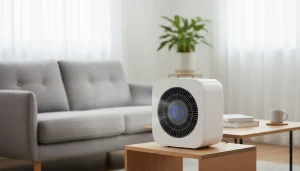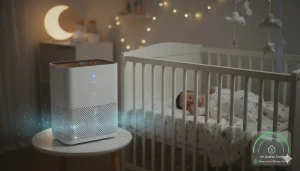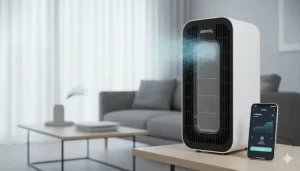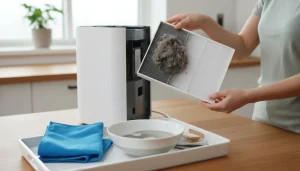Clean air isn’t a luxury—it’s essential. Yet, most homes and offices are filled with invisible pollutants: dust, pet dander, smoke, and allergens. That’s where air purifier come in.
This guide will help you understand how air purifiers work, which ones actually deliver results, and how to choose the best one for your needs.

What Is an Air Purifier?
An air purifier is a device that removes contaminants from indoor air. It uses filters or advanced purification technologies to trap particles like dust, smoke, and bacteria.
Most modern units combine HEPA filters, activated carbon, and sometimes UV-C light to capture and neutralize harmful elements.
In short: air purifiers make your air safer to breathe—especially in cities with high pollution or homes with pets and allergies.
Why You Need an Air Purifier
Even if your home appears spotless, the air you breathe indoors can be up to five times more polluted than outdoor air. Everyday activities — like cooking, cleaning, or simply living with pets — release tiny particles and pollutants into the air. Dust mites, pet dander, mold spores, and fumes from paints or furniture (VOCs) can linger and build up over time, affecting your health and comfort.
An air purifier works to capture and eliminate these invisible contaminants, creating a cleaner and safer environment for you and your family. The result? Fewer allergy symptoms, better sleep, fresher air, and easier breathing — especially for children, the elderly, and anyone with sensitivities.
How Air Purifiers Work
Air purifiers clean your indoor air by pulling it through a series of advanced filters, each designed to target different types of pollutants. This multi-stage process ensures that the air you breathe is free from dust, allergens, smoke, and even harmful microorganisms. Here’s how each stage works:

1. HEPA Filters (High-Efficiency Particulate Air)
These are the heart of most purifiers. A true HEPA filter can capture up to 99.97% of airborne particles as small as 0.3 microns — including dust, pollen, pet dander, and mold spores. This makes it especially helpful for people with allergies or asthma.
2. Activated Carbon Filters
While HEPA filters trap particles, activated carbon filters absorb gases, odors, and chemicals that HEPA can’t catch. The porous carbon surface locks in smoke, cooking smells, and volatile organic compounds (VOCs) released from furniture, cleaning products, or paint — keeping your home smelling fresh and toxin-free.
3. UV-C Light or Ionizer Technology
Some purifiers use UV-C light to destroy bacteria, viruses, and germs by damaging their DNA, preventing them from reproducing. Others use ionizers to release negatively charged ions that attach to airborne particles, making them easier to trap or settle.
Curious about what’s happening inside your device? Discover the science behind clean air in our detailed guide on [How Air Purifiers Work] — learn how each filter and technology keeps your indoor air healthy.
Best Air Purifier You Can Trust (Expert Picks)
We’ve tested dozens of models and selected only those that balance performance, value, and reliability. Below are our top expert-recommended air purifiers by category.
Coway AP-1512HH Mighty – Best Overall
Why we recommend it:
Coway Mighty is designed for exceptional air purification in medium to large rooms. Its sleek build and quiet operation make it ideal for home or office use. Built with long-lasting quality and smart performance, it’s a trusted favorite among air purifiers. Compact, quiet, and powerful.
Benefits:
- Cleans 361 sq ft in 12 minutes
- Energy-efficient Eco mode
- True HEPA + carbon combo
Cons:
- Bright indicator lights
- Limited smart features
Levoit Core 400S – Best for Pets and Allergies

Why we recommend it:
Designed to handle medium-to-large rooms, the Levoit Core 400S features a 3-stage filtration system (including a True HEPA filter and activated carbon) that captures 99.97% of particles like pet dander, pollen, dust, and even volatile organic compounds.
Benefits:
- Traps pet dander and hair effectively
- Connects with Alexa and smartphone app
- Sleek design fits any décor
Cons:
- Filters need to be replaced every 6–12 months.
- Best suited for medium to large rooms.
Blueair Blue Pure 211+ – Best for Smoke & Large Spaces

Why we recommend it:
Packed with HEPASilent™ filtration, the 211+ rapidly clears smoke, cooking fumes, and fine dust across wide indoor areas — making it a top pick for open-plan homes.
Benefits:
- Covers up to 540 sq ft
- Washable pre-filter
- Excellent for open-plan homes
Cons:
-
Pre-filter needs regular cleaning.
-
It can be noisy on high settings
Medify MA-25 – Best for Baby Rooms

Why we recommend it:
Designed for nurseries and smaller rooms, the Medify MA‑25 combines ultra-quiet operation with medical-grade H13 HEPA filtration. Its compact design, night mode, and child lock make it perfect for keeping your baby’s room fresh and allergen-free.
Benefits:
- H13 HEPA filter
- Child lock and night mode
- Compact and easy to move
Cons:
- Compact size ideal for small rooms
- Filter replacement is required periodically
Airdog X3 – Best Smart & Filterless Option

Why we recommend it:
The Airdog X3 features a washable, reusable filterless system, saving money over time while maintaining high air purification. With app-controlled air quality tracking and a sleek, modern design, it’s perfect for tech-savvy users who want smart, low-maintenance performance.
Benefits:
- App-controlled air quality tracking
- Zero filter replacement cost
- Sleek, modern look
Cons:
- Requires regular cleaning
- Best for medium-sized rooms
How to Clean and Maintain Your Air Purifier
Proper maintenance is key to keeping your air purifier performing at its best and ensuring the air in your home stays clean and healthy. Regular care prevents dust buildup, maintains airflow, and prolongs the life of your device. Here’s a detailed guide:

- Replace HEPA Filters Every 6–12 Months
Over time, HEPA filters become saturated with dust, pollen, and other particles. Replacing them on schedule ensures your purifier continues to capture 99.97% of airborne pollutants. - Wash Pre-Filters Monthly
Pre-filters trap larger particles like hair and dust. Washing them regularly keeps airflow optimal and reduces strain on the main HEPA filter. - Clean Sensors and Vents
Wipe down air intake vents, output vents, and any sensors with a soft, damp cloth. Clean sensors ensure accurate air quality readings and efficient operation. - Check for Wear and Tear
Inspect cords, buttons, and moving parts to make sure everything functions smoothly. This prevents unexpected breakdowns and keeps your purifier safe. - Maintain Consistent Cleaning Habits
Dust accumulation around your purifier or in the room can reduce efficiency. Keeping the surrounding area clean supports overall performance.
For a step-by-step guide on keeping your device in top condition, see [How to Clean and Maintain Your Air Purifier]. Regular care not only extends the lifespan of your purifier but also guarantees cleaner, healthier air for your home.
Health Benefits Backed by Science
Air purifiers offer more than just fresher air—they have measurable effects on health and well-being. Scientific studies show that using a quality air purifier can:
- Reduce airborne allergens by 60–90%, helping allergy sufferers breathe easier.
- Improve asthma symptoms by removing fine dust, pollen, and other triggers.
- Enhance sleep quality by minimizing irritants that disrupt rest.
- Decrease respiratory infections in areas with high pollution or smoke exposure.
By filtering out harmful particles, air purifiers support overall respiratory health and contribute to a cleaner, safer indoor environment.
Eco-Friendly and Energy-Saving Air Purifiers
For those conscious about sustainability, selecting an energy-efficient, eco-friendly air purifier can make a meaningful difference. Look for models with Energy Star certification, which ensures lower electricity consumption while maintaining high performance.
Many brands, such as Airdog and Blueair, offer reusable or washable filters, reducing plastic waste from disposable filters and lowering long-term maintenance costs. These eco-friendly designs not only save energy and cut your utility bills but also minimize environmental impact without compromising on air purification effectiveness.
Choosing a sustainable model lets you enjoy cleaner air while supporting a greener lifestyle.
Placement Tips for Maximum Efficiency
Proper placement of your air purifier ensures it cleans the air effectively and quickly. Follow these tips for optimal performance:
-
Central Location: Place the purifier in the main living area or where you spend the most time. Avoid corners or behind furniture, which can block airflow.
-
Elevated Position: Position the unit a few feet off the ground on a table or stand to improve circulation and capture airborne particles more efficiently.
-
Keep Clear Space Around: Ensure at least 1–2 feet of clearance on all sides for unrestricted air intake and output.
-
Avoid Obstacles: Don’t place the purifier near curtains, walls, or electronics that can disrupt airflow.
-
Multiple Units for Large Spaces: For open-plan or larger rooms, consider using two purifiers strategically placed to cover all areas.
Proper placement maximizes air circulation, filtration efficiency, and overall performance, helping you breathe cleaner air throughout your home.
